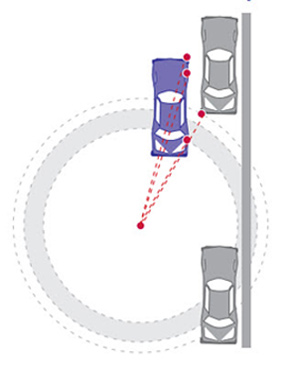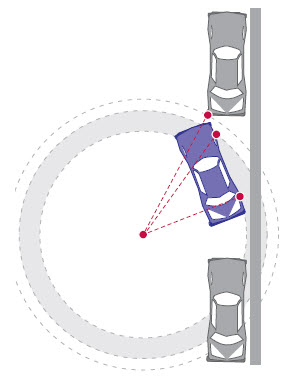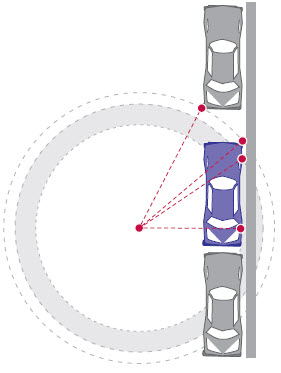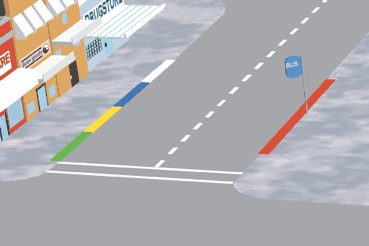Parking
Parking is when you stop and allow your vehicle to stay in one place, whether or not you leave the vehicle unattended. Parking is allowed in many places on the road and in road-related areas and you should always obey any signs.
At all times when stopping or parking, you must not open the doors of the vehicle so as to endanger bicycle riders, pedestrians or other road users.
Parking On A Hill
When you park:
- On a sloping driveway, turn the wheels so the vehicle will not roll into the street if the brakes fail.
- Headed downhill, turn your front wheels into the curb or toward the side of the road. Set the parking brake.
- Headed uphill, turn your front wheels away from the curb and let your vehicle roll back a few inches. The wheel should gently touch the curb. Set the parking brake.
- Headed either uphill or downhill when there is no curb, turn the wheels so the vehicle will roll away from the center of the road if the brakes fail.
Always set your parking brake and leave the vehicle in gear or in the “park” position.

Downhill: turn the wheels toward the curb.
Uphill: turn the wheels away from the curb.
No curb: turn the wheels toward the shoulder of the road.
Parallel Parking
Parallel parking is a driving technique which allows you to park parallel to the road in line with other parked vehicles. The steps below explain how to parallel park safely.
- Find a space. Look for a space at least 3 feet longer than your vehicle. When you find a space, signal that you intend to park.
- Pull your vehicle alongside the space or vehicle in front of where you intend to park. Leave approximately 2 feet between the vehicle or space next to you and stop once your rear bumper is aligned to the front of the space where you
want to park. Check your rearview mirror and look over your shoulder for approaching vehicles. Keep your foot on the brake and put the vehicle in reverse. Maintain the signal.. - Lift your foot off the brake. Before backing up, check your mirrors and look over your shoulder for any hazards. Begin to back up, at approximately a 45 degree angle.
- Straighten out. Begin turning the steering wheel away from the curb when your rear wheel is within 18 inches from the curb. You may need to pull forward and backward to straighten out. Your vehicle should now be parallel and no further than 18 inches from the curb.
Step 1
3Bring your car to a stop alongside the car at the front of the space.

Step 2
Reverse into the space with an S motion.
Step 3
Once the car is parallel with the curb, pull forward to center your car within the space.
Parking At Colored Curbs
Painted colored curbs have the following special parking rules:
White–Stop only long enough to pick up or drop off passengers or mail.
Green–Park for a limited time. Look for a posted sign next to the green zone for time limits, or locate the time limit painted on the curb.
Yellow–Stop no longer than the time posted to load or unload passengers or freight. Drivers of noncommercial vehicles are usually required to stay with the vehicle.

Red–No stopping, standing, or parking (buses may stop at a red zone marked for buses).

Blue–Parking is permitted only for a disabled person or driver of a disabled person who displays a placard or special license plate for disabled persons or disabled veterans. A crosshatched (diagonal lines) area adjacent to a designated disabled parking
space is a no parking area. For information or an application for disabled parking placards or special plates, visit www.dmv.ca.gov or call 1-800-777-0133.
Example of crosshatched (diagonal lines) area
Placard abuse results in the loss of special parking privileges. It is also a misdemeanor and punishable by a fine of up to $1,000, imprisonment in county jail for up to 6 months, or both.
Examples of disabled placard/plate abuse:
- Using a placard/plate after it has been reported lost or stolen without reporting that the placard/plate was found.
- Loaning your placard/plate to friends or family members (disabled or not).
- Interchanging placards with friends or family members.
- Using a placard/plate when the person it was issued to is not in the vehicle with you (disabled child, family member, employer, etc.).
- Using a deceased person’s placard/plate.
You must return the placard/plate of the deceased disabled person to a DMV field office or mail to:
DMV
PO Box 942869, MS D238
Sacramento, CA 94269-0001
Illegal Parking
Never park or leave your vehicle:
- Where a “No Parking” sign is posted.
- On a marked or unmarked crosswalk, sidewalk, partially blocking a sidewalk, or in front of a driveway.
- Within 3 feet of a sidewalk ramp for disabled persons or in front of or on a curb that provides wheelchair access to a sidewalk.
- In a disabled person parking space, unless you are disabled and display a placard or disabled person license plates.
- In the space next to a disabled person parking space, if it is painted in a crosshatched (diagonal) pattern (CVC §22507.8(c)(2)).
- In a space designated for parking or fueling zero emission vehicles that display an identifying decal, unless you are driving a zero emission vehicle that you will charge in the space.
- In a tunnel or on a bridge, except where permitted by signs.
- Within 15 feet of a fire hydrant or a fire station driveway.
- On or within 7½ feet of a railroad track.
- Between a safety zone and the curb.
- “Double parked.” (Parking in the street when all legal parking places at the curb are taken.)
- On the wrong side of the street.
- At a red curb.
- On a freeway, except:
- In an emergency.
- When a peace officer or device requires a stop.
- Where a stop is specifically permitted.
If you must stop on a freeway, park completely off the pavement and stay in your vehicle with the doors locked until help arrives. Leave enough space for other vehicles to freely pass by your vehicle. Your vehicle should be visible for at least 200 feet in each direction. A vehicle (even if disabled) that is stopped, parked, or left standing on a freeway for more than 4 hours may be removed (CVC §22651(f)).
Special Parking Rules
- When you park alongside a curb on a level street, the front and back wheels must be parallel and within 18 inches of the curb. Park parallel to the street if there is no curb.
- Never leave your vehicle while the engine or the electric motor is still running; stop the engine or the electric motor and set the parking brake.
- When you are ready to exit your vehicle, look carefully for passing vehicles, bicyclists, and motorcyclists. Do not open the door unless it is safe and you do not interfere with traffic. Do not leave the door open longer than necessary.
- Disabled people with a placard or special plates may park in any parking zone that is restricted as to the length of time parking is permitted as indicated by a sign pursuant to a local ordinance.
- Pursuant to CVC §22511, a local authority, by ordinance or resolution, may designate stalls or spaces on a public street within its jurisdiction for the exclusive purpose of charging and parking a vehicle that is connected for electric charging purposes.

